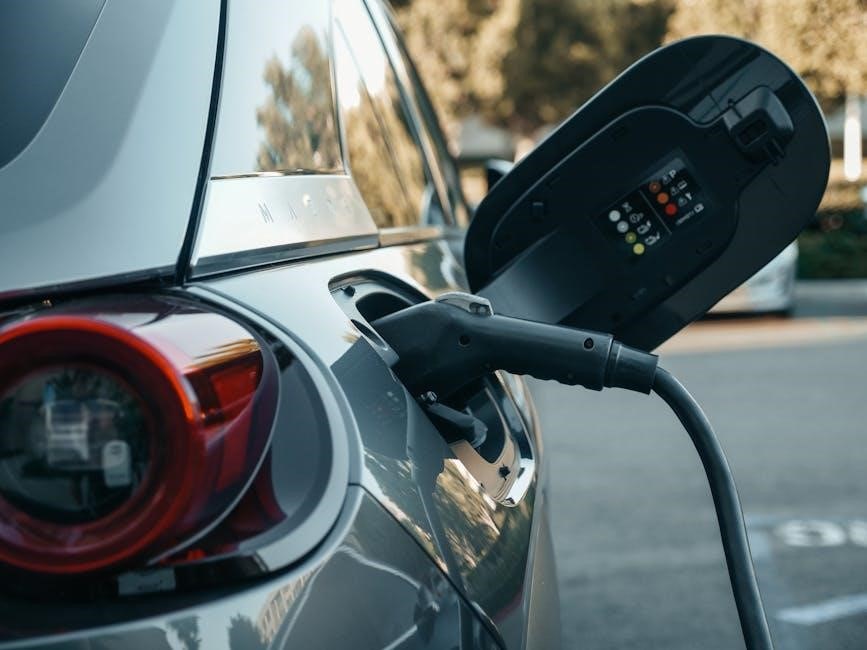Selecting the right battery is crucial for your vehicle’s reliability and performance. Consider size‚ CCA‚ type‚ and climate. A proper fit ensures optimal power and longevity always.
Understanding the Importance of Battery Selection
Selecting the right battery is vital for your vehicle’s electrical system and engine performance. A mismatched battery can lead to poor starting power‚ dim lights‚ and shortened lifespan. Extreme temperatures further complicate this‚ as cold weather demands higher cold cranking amps (CCA) for reliable starts‚ while hot weather can drain battery capacity. Choosing the right type‚ whether flooded or AGM‚ ensures optimal performance for your driving conditions. Proper selection also prevents damage to your car’s electrical components and avoids unexpected breakdowns. By understanding your vehicle’s needs‚ you ensure smooth operation‚ reliability‚ and longevity of your battery and electrical system.
Key Factors to Consider When Choosing a Battery
When selecting a battery‚ several factors are essential to ensure compatibility and performance. Battery size‚ determined by BCI group size‚ must fit your vehicle’s compartment. Cold cranking amps (CCA) should meet or exceed your car’s requirements‚ especially in cold climates. Battery type‚ such as flooded or AGM‚ impacts performance and maintenance needs. Reserve capacity and deep cycle capabilities matter for vehicles with high power demands. Climate conditions‚ warranty‚ and maintenance requirements also play a role. Consulting your owner’s manual or a professional can help narrow down the best options‚ ensuring reliable performance and longevity for your vehicle’s electrical system and engine.

Determining the Correct Battery Size
Check your owner’s manual or battery label for the correct BCI group size. Measure your vehicle’s battery compartment to ensure a proper fit for reliable performance always.
Understanding Battery Group Size (BCI Group Size)
Battery Council International (BCI) group size categorizes batteries by physical dimensions and terminal placement. Each size ensures compatibility with specific vehicles‚ guaranteeing a secure fit. Always consult your owner’s manual or battery label to confirm the correct group size for your vehicle. This standardization simplifies the selection process‚ ensuring the battery fits properly in the compartment and connects securely to the terminals. Proper fitment prevents issues like loose connections or insufficient clearance‚ which can lead to reduced performance or safety hazards. Using the wrong size may result in poor electrical connections or inadequate power delivery‚ affecting overall vehicle functionality.
How to Measure and Match Your Vehicle’s Battery Compartment
To ensure a proper fit‚ measure your vehicle’s battery compartment by checking its length‚ width‚ and height. Use the BCI group size from your owner’s manual or the battery label as a guide. If unsure‚ measure the existing battery or the compartment directly. Ensure the new battery’s dimensions match these measurements precisely. Proper fitment prevents issues like loose connections or inadequate clearance. Use tools like a tape measure or online lookup tools to confirm compatibility. A well-fitting battery ensures secure installation‚ optimal performance‚ and safety. Always verify terminal placement and alignment to avoid connectivity problems.

Cold Cranking Amps (CCA) and Its Significance
Cold Cranking Amps (CCA) measure a battery’s ability to start an engine in cold temperatures. Higher CCA ensures reliable starts‚ especially in freezing conditions‚ making it essential for winter performance.
What is CCA and Why It Matters
Cold Cranking Amps (CCA) is a measure of a battery’s ability to deliver power in cold temperatures. It indicates how many amps a battery can provide for 30 seconds at 0°F while maintaining voltage above 7.2V. CCA matters because it ensures your vehicle starts reliably in freezing conditions. A higher CCA rating improves starting power‚ especially for engines with higher compression or in extreme cold. Using a battery with insufficient CCA can result in poor starting performance or failure to start‚ which is why matching or exceeding your vehicle’s minimum CCA requirement is essential for consistent reliability.
How to Determine Your Vehicle’s Minimum CCA Requirement
To find your vehicle’s minimum CCA requirement‚ consult the owner’s manual or manufacturer’s specifications. The manual typically lists the recommended CCA rating for your car’s make‚ model‚ and year. Additionally‚ you can check the battery compartment or the manufacturer’s website for this information. Some auto parts stores also offer tools or databases to help determine the correct CCA for your vehicle. It’s important to avoid guessing‚ as a battery with insufficient CCA may fail to start your car‚ especially in cold weather. Always aim to meet or exceed the recommended rating for reliable performance.

Battery Types: Flooded vs. AGM
Flooded batteries are cost-effective and traditional‚ while AGM batteries offer superior performance‚ durability‚ and maintenance-free operation‚ making them ideal for vehicles with high power demands and extreme conditions.
Understanding Flooded Lead-Acid Batteries
Flooded lead-acid batteries are the traditional choice‚ offering reliable performance at a lower cost. They use liquid electrolyte‚ requiring periodic maintenance like topping off water levels. Suitable for standard vehicles‚ they provide ample starting power and are widely used in everyday cars. However‚ they may not perform as well in extreme temperatures or deep-cycle applications. Despite this‚ their affordability and simplicity make them a popular option for many drivers. Proper care ensures longevity‚ but they are less ideal for high-demand or harsh weather conditions compared to AGM alternatives.
Advantages of Absorbed Glass Mat (AGM) Batteries
AGM batteries excel in performance and durability‚ making them ideal for modern vehicles with high power demands. Their glass mat design absorbs electrolyte‚ preventing spills and allowing installation in various orientations. AGM batteries offer superior cold-weather performance‚ higher cold cranking amps‚ and better deep-cycle capabilities. They are maintenance-free‚ with a longer lifespan and enhanced vibration resistance. These features make AGM batteries perfect for extreme temperatures‚ luxury vehicles‚ and systems requiring reliable power. While more expensive than flooded batteries‚ their superior performance and durability justify the investment for drivers seeking top-tier reliability and extended battery life in demanding conditions.
Choosing the Right Battery Type for Your Vehicle
Selecting the correct battery type ensures optimal performance and longevity. Flooded batteries are cost-effective and suitable for standard vehicles‚ while AGM batteries offer superior performance‚ especially in extreme temperatures and high-demand systems. Consider your climate‚ driving habits‚ and vehicle requirements. For cold weather or advanced features like remote start‚ AGM is recommended. Flooded batteries suffice for basic needs and budget-conscious buyers. Always refer to your owner’s manual or consult an expert to match your vehicle’s specifications‚ ensuring a reliable and efficient power supply tailored to your specific automotive needs and preferences.

Special Considerations for Extreme Weather
Extreme temperatures affect battery performance. AGM batteries are ideal for both hot and cold climates‚ offering superior durability. Cold weather reduces CCA‚ while heat accelerates degradation. Choose wisely for reliability.
Impact of Cold Weather on Battery Performance
Cold weather significantly impacts battery efficiency‚ reducing its ability to hold a charge and start engines. Lower temperatures decrease the battery’s chemical reactions‚ leading to weaker performance. The cold cranking amps (CCA) rating becomes crucial‚ as it measures the battery’s capacity to deliver power in freezing conditions. A higher CCA rating ensures reliable starts. Additionally‚ cold weather can cause battery fluids to freeze‚ potentially damaging internal components. To combat this‚ choose a battery designed for cold climates and maintain a full charge. Parking in a garage and using a battery blanket can also help protect against extreme cold. Proper maintenance is key to preventing winter-related battery issues.
- Cold reduces battery efficiency and starting power.
- Higher CCA ratings improve cold-weather performance.
- Freezing temperatures can damage battery internals.
- Regular maintenance and charging are essential.
Handling Hot Weather and High-Temperature Conditions
Excessive heat can significantly degrade battery performance and lifespan. High temperatures accelerate chemical reactions‚ causing batteries to discharge faster and lose capacity. Heat can also evaporate battery fluids‚ leading to reduced efficiency and potential damage; To mitigate this‚ opt for batteries designed for high-temperature environments‚ such as AGM batteries‚ which are more resilient to heat. Regular checks on fluid levels and terminal connections are essential. Parking in shaded areas or using heat-protective covers can also help maintain battery health. Avoiding extreme temperature fluctuations ensures optimal performance and extends battery life in hot climates.
- Heat accelerates battery degradation and discharge.
- AGM batteries are ideal for high-temperature conditions.
- Regular fluid checks and secure connections are vital.
- Shade and protective covers reduce heat exposure.

Additional Features to Look For
Consider reserve capacity for extended power needs and deep cycle capabilities for frequent discharging. Look for warranties and maintenance-free designs to ensure durability and convenience.
- Reserve capacity supports auxiliary systems.
- Deep cycle batteries handle repeated draining.
- Warranty length indicates product reliability.
Reserve Capacity and Deep Cycle Capabilities
Reserve capacity (RC) measures a battery’s ability to power auxiliary systems when the alternator isn’t running. Higher RC is ideal for vehicles with high electrical demands. Deep cycle capability refers to a battery’s ability to handle repeated deep discharging and recharging‚ essential for systems requiring consistent power over time. Both features are critical for vehicles with advanced electronics or those used for off-grid applications. Ensure the battery you choose aligns with your vehicle’s power needs and usage patterns‚ as insufficient capacity can lead to premature failure. Always consult your owner’s manual for specific recommendations.
Warranty and Maintenance Requirements
When selecting a battery‚ consider the warranty and maintenance needs. A longer warranty often indicates higher quality. Flooded batteries may require periodic topping up of distilled water‚ while AGM batteries are maintenance-free. Ensure terminals are clean and secure to prevent corrosion‚ which can reduce performance. For deep cycle applications‚ consider a battery with a compatible charger‚ like the OptiMate 7‚ to maintain health; Always follow the manufacturer’s maintenance guidelines for optimal longevity. Checking your owner’s manual will provide specific recommendations tailored to your vehicle‚ ensuring you get the most out of your battery investment.

How to Choose the Best Battery for Your Vehicle
Consult your vehicle’s owner’s manual or a trusted mechanic for recommendations. Evaluate your driving habits‚ climate‚ and performance needs to narrow down options effectively.
Using Your Vehicle’s Owner’s Manual
Your vehicles owner’s manual is a vital resource for selecting the right battery. It specifies the required battery size‚ type‚ and performance ratings‚ ensuring compatibility and optimal performance. By referencing the manual‚ you can identify the correct BCI group size‚ CCA rating‚ and battery type recommended for your vehicle. Additionally‚ it may provide insights into special features needed‚ such as deep cycle capabilities or resistance to extreme temperatures. If unsure‚ cross-check the manual with your current battery or consult the manufacturer’s website for detailed specifications. This step ensures a precise match‚ avoiding potential issues with fitment or functionality.
Consulting with Auto Parts Stores or Mechanics
Consulting with auto parts stores or mechanics is an excellent way to ensure you select the right battery. Professionals can provide personalized recommendations based on your vehicle’s make‚ model‚ and year‚ as well as your driving habits and local climate. They can help you interpret specifications like CCA‚ reserve capacity‚ and battery type‚ ensuring compatibility and performance. Additionally‚ many auto parts stores offer free battery testing and installation services‚ while mechanics can provide insights into potential upgrades or special requirements. Their expertise can save time‚ prevent mistakes‚ and ensure your vehicle runs smoothly with the correct battery.

Installation and Maintenance Tips
Proper installation ensures safety and performance. Secure terminals tightly‚ apply anti-corrosion spray‚ and use protectors. Regularly check charge levels‚ clean connections‚ and test battery health to extend lifespan.
Proper Installation Techniques
Proper installation is vital for battery performance and safety. Start by disconnecting the negative terminal first to prevent electrical shocks. Clean the terminals and battery tray to ensure a secure fit. Align the battery correctly in the compartment‚ ensuring it matches the vehicle’s specifications. Reconnect the positive terminal first‚ followed by the negative‚ tightening all connections firmly. Apply terminal protectors and anti-corrosion spray to prevent damage. Finally‚ test the electrical system to ensure everything functions correctly. Always follow the manufacturer’s guidelines for a safe and efficient installation process that maximizes battery life and reliability.
Preventing Corrosion and Extending Battery Life
Preventing corrosion and extending battery life requires regular maintenance. Apply terminal protectors and anti-corrosion sprays to shield connections from damage. Clean terminals with a wire brush and baking soda solution to remove rust. Ensure the battery is securely fastened to prevent vibrations. Avoid overcharging‚ as it can reduce battery lifespan. Check terminals regularly for signs of wear or corrosion. Use a battery maintainer during long storage or in extreme cold. Proper care ensures reliable performance and extends the battery’s life‚ preventing premature failure and enhancing your vehicle’s overall electrical system efficiency.
Frequently Asked Questions
Common questions include whether higher CCA batteries are safe and the impact of using the wrong battery type. Always consult your vehicle’s manual for precise guidance.
Can I Use a Battery with a Higher CCA Rating?
Using a battery with a higher CCA rating than required is safe and beneficial. It enhances starting power‚ especially in cold conditions‚ without damaging your vehicle’s electrical system. Higher CCA ensures reliable engine starts and improved performance in extreme weather. However‚ never use a battery with a lower CCA rating than recommended‚ as it may fail to start your vehicle. Always consult your owner’s manual for the minimum CCA requirement and choose a battery that meets or exceeds this specification for optimal performance and longevity.
What Happens If I Use the Wrong Battery Type?
Using the wrong battery type can lead to poor performance and potential damage to your vehicle’s electrical system. If your car requires an AGM battery but you install a flooded one‚ it may not provide the necessary power‚ especially for high-demand features like heated seats or advanced electronics. This mismatch can cause unreliable starts‚ reduced battery life‚ and increased risk of electrical component failure. Always ensure the battery type matches your vehicle’s specifications to maintain optimal performance and avoid costly repairs. Consult your owner’s manual or a professional for guidance to make the right choice.
